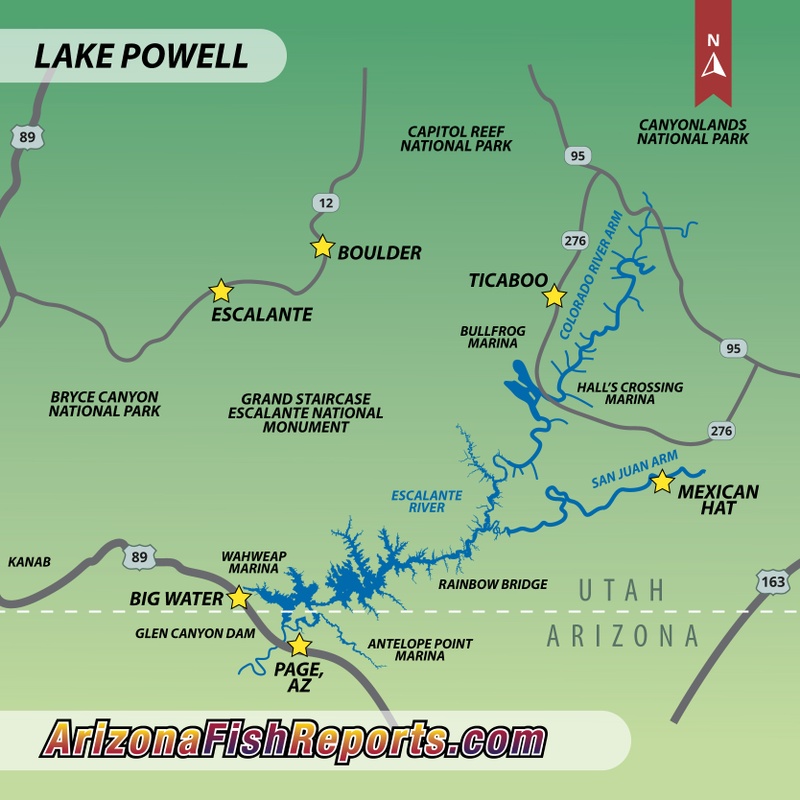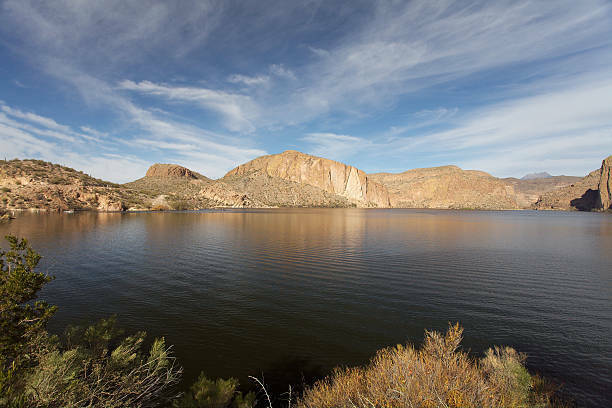Lake Powell Fish Report for 3-31-2024
Lake Powell Fishing Report
Lake Powell

by Arizona Game & Fish Department
3-31-2024
Website
Provided by Dan Keller on www.wayneswords.net, 3/17/2024. Water temperature (Wahweap Bay) 47 F. Lake elevation 3,559.65 MSL (and dropping). Expect water levels to remain steady or slowly drop during the month of March. Beginning in April, water levels will start to rise. Snow levels in the Upper Colorado River Basin are near or above average and we went into the winter with good soil conditions. It’s hard to know exactly what runoff will do for Lake Powell this
spring, however the late season snow storms certainly helped. Morning water temperature is holding around 48 degrees, the two-week weather forecast calls for daytime air temperatures in the upper 50s to mid-60s. In general, March is characterized by a slow warming trend. Expect to see this warming trend after the high wind forecast the first few days of March passes. That means fishing success
will improve with each passing day until the next storm front. Water temperatures could reach 53-56 degrees in the afternoon by the end of next week. Mid 50s start to wake up Lake Powell fish. Here is what to expect for each species.
Largemouth Bass: As temps warm, bass will begin chasing sunfish, so if largemouth bass is your target, be on the lookout for cover and sunfish. By doing so, you will be positioned well to catch lots of bass. It’s still too cold for fast-moving presentations; the lure must be placed in or really close to cover, so a weedless presentation is often best. Use a slow retrieve so fish have time to get a good look before deciding to bite. With the lake rising 65 feet last year, cover is plentiful; it won’t be hard to find flooded brush/trees. This is good news for bass anglers, especially in two to three years
when the cohort produced in 2023 has grown up enough to be caught with regularity. If you have side scan features of your sonar, this is a perfect opportunity to use your electronics to pick out fish in cover.
Crappie: Similar to largemouth, crappie really like to live near flooded vegetation and cover. When brush is absent, crappie seek out a certain water depth, holding over a ledge or drop-off, or colored water. There is no shortage of flooded vegetation in the back of canyons, simply look for vegetation growing along sandy shorelines with moderate slopes and follow that line of vegetation down to the water line and look for submerged vegetation (if water is clear) or use sonar to detect underwater
cover. Again, thanks to the vast amount of vegetation that was submerged in 2023, it won’t be difficult to find cover. However, it likely will take some time to locate a good concentration of crappie. Look in the back of canyons where water depth is 12 to 25 feet with green to muddy water color. I like to use a slip bobber rig; adjusting the bobber stop allows me to suspend a small jig right over the brush, maximizing time in the “strike zone” while minimizing the frustration of snagging brush. I also like to use red wiggler worms to entice crappie.
Smallmouth Bass: Smallmouth prefer rock structure for cover, so it is easier to locate them with plastic grubs fished on rocky shelves, in boulder fields, or at the edge of drop-offs and other shallow areas from 30 feet deep to the shallow shoreline. The key to springtime bass fishing is to find the warmest water available. Pay close attention to water temps as you move around a cove or work along a shoreline. Focusing on even slightly warmer water can make a big difference in the number of fish you catch.
Walleye: It is spawning season for walleye. Targeting walleye during the spawn is difficult. Walleye fishing at Lake Powell turns on in April and May. Large females are still actively eating shad and can be located in green to muddy water in the backs of canyons. If shad are present and swimming in open water, big female walleye can be caught trolling and casting. My best walleye trip last year was May 1-2, trolling a fire tiger flicker shad in the back of Escalante. When trolling for walleye, it is always best to fish at a water depth where the lure occasionally hits bottom. The most effective
trolling method may be a bottom bouncer that can hit bottom at various depths. Walleye are bottom oriented, so a very effective technique is to simply hook a piece of worm to a bass jig and slowly work that along the bottom structure. Troll to cover lots of water and find active walleye, then be ready to cast curly tail jigs tipped with worm.
Striped Bass: Expect to cover lots of fishless water before locating a school, get comfortable behind your sonar (pack lots of snacks), and spend the required time locating a big school before working too hard at enticing them to bite. Starting out trolling is a good strategy for finding a school, even if the fish are holding deeper than your lure, at least you have a chance of catching fish while searching. Once stripers are located, quickly drop a spoon while holding over the school. In the springtime, stripers can often be caught in the backs of canyons with lures or in deep water of the
main channel eating bait. So far this year, cut bait hasn’t been needed or really effective. Anglers are having great success on the north end from Red Canyon up to the Horn with spoons, jigs, and trolling. There are plenty of stripers on the south end too, and I expect with more boats getting out over the next few weeks, anglers will start to figure them out. The condition of stripers is excellent right now; with the big production of shad in 2023, we expect stripers to remain healthy. Stripers can
be more difficult to catch when they are so well fed; however, I think most anglers prefer to catch fewer but healthy, hard-fighting fish rather than loads of easy-to-catch, thin, starving stripers that dominate when shad run low. Of course, catching loads of fat fish is always the goal, and that is absolutely a likely outcome right now at Lake Powell. Spring 2024 is primed for fantastic striper fishing. Get a trip planned and get on the water!
More Reports
Arizona Game & Fish Department Reports
for Sunday, March 31stKaibab Lake: The lake level is below the end of the boat launch
Cataract Lake: The lake is full
City Reservoir: The road into City Reservoir is closed for the winter
Dogtown Lake: Access to the lake is open, but the campground is closed for the winter
Santa Fe Reservoir: The lake is full and spilling over
Whitehorse Lake: With the recent snow storms, road conditions are likely muddy
J. D. Dam Lake: Complete ice cover likely this week
Russel Tank: Ice may be present
Upper & Lower Lake Mary: Upper and Lower Lake Mary Fishing Report
Francis Short Pond: The City has worked tirelessly to remove literally tons of ash, debris, and sediment from the pond
Ashurst Lake: Ashurst Lake Fishing Report
Kinnikinick Lake: The lake is full and turbid
Apache Lake: Apache Lake Report
Bartlett Lake: Bartlett Lake Fishing Report
Fain Lake: Fain Lake Fishing Report
Oak Creek: Oak Creek Report
West Clear Creek: Smallmouth bass are unlimited harvest in West Clear Creek
Golden algae-caused fish kills confirmed at Saguaro, Canyon lakes
Canyon Lake (AZ)
3-15-2024
The Arizona Game and Fish Department (AZGFD) has confirmed golden algae toxin blooms as the cause of recent fish kills...... Read More

Website Hosting and Design provided by TECK.net